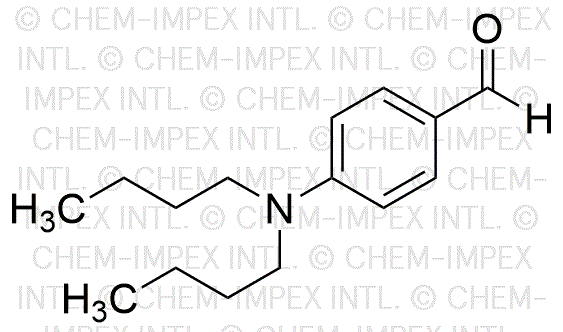4-(Dibutylamino)benzaldehyde is widely utilized in research focused on:
- Organic Synthesis: This compound serves as a versatile intermediate in the synthesis of various organic compounds, particularly in the development of pharmaceuticals and agrochemicals.
- Fluorescent Dyes: It is used in the production of fluorescent dyes, which are essential in biological imaging and diagnostics, allowing researchers to visualize cellular processes effectively.
- Polymer Chemistry: The compound is incorporated into polymer formulations to enhance properties such as thermal stability and mechanical strength, making it valuable in the plastics industry.
- Analytical Chemistry: It acts as a reagent in analytical methods, assisting in the detection and quantification of various substances, which is crucial for quality control in manufacturing.
- Biological Research: Researchers utilize it to study enzyme interactions and cellular mechanisms, contributing to advancements in drug discovery and development.
General Information
Properties
Safety and Regulations
Applications
4-(Dibutylamino)benzaldehyde is widely utilized in research focused on:
- Organic Synthesis: This compound serves as a versatile intermediate in the synthesis of various organic compounds, particularly in the development of pharmaceuticals and agrochemicals.
- Fluorescent Dyes: It is used in the production of fluorescent dyes, which are essential in biological imaging and diagnostics, allowing researchers to visualize cellular processes effectively.
- Polymer Chemistry: The compound is incorporated into polymer formulations to enhance properties such as thermal stability and mechanical strength, making it valuable in the plastics industry.
- Analytical Chemistry: It acts as a reagent in analytical methods, assisting in the detection and quantification of various substances, which is crucial for quality control in manufacturing.
- Biological Research: Researchers utilize it to study enzyme interactions and cellular mechanisms, contributing to advancements in drug discovery and development.
Documents
Safety Data Sheets (SDS)
The SDS provides comprehensive safety information on handling, storage, and disposal of the product.
Product Specification (PS)
The PS provides a comprehensive breakdown of the product’s properties, including chemical composition, physical state, purity, and storage requirements. It also details acceptable quality ranges and the product's intended applications.
Certificates of Analysis (COA)
Search for Certificates of Analysis (COA) by entering the products Lot Number. Lot and Batch Numbers can be found on a product’s label following the words ‘Lot’ or ‘Batch’.
Numéro de catalogue
Numéro de lot/série
Certificates Of Origin (COO)
This COO confirms the country where the product was manufactured, and also details the materials and components used in it and whether it is derived from natural, synthetic, or other specific sources. This certificate may be required for customs, trade, and regulatory compliance.
Numéro de catalogue
Numéro de lot/série
Safety Data Sheets (SDS)
The SDS provides comprehensive safety information on handling, storage, and disposal of the product.
DownloadProduct Specification (PS)
The PS provides a comprehensive breakdown of the product’s properties, including chemical composition, physical state, purity, and storage requirements. It also details acceptable quality ranges and the product's intended applications.
DownloadCertificates of Analysis (COA)
Search for Certificates of Analysis (COA) by entering the products Lot Number. Lot and Batch Numbers can be found on a product’s label following the words ‘Lot’ or ‘Batch’.
Numéro de catalogue
Numéro de lot/série
Certificates Of Origin (COO)
This COO confirms the country where the product was manufactured, and also details the materials and components used in it and whether it is derived from natural, synthetic, or other specific sources. This certificate may be required for customs, trade, and regulatory compliance.


